Before beginning your roofing project, it is imperative to measure the roof correctly. A gable roof is usually easy to measure, but more intricate tasks like mansards and gambrels will require more intricacy. The more complex the roof, the more waste will occur, particularly if shingles need to be cut to fit small spaces or laid in even rows along the roof deck. There’s no one exact square foot for roofing, so the term “roof square” is useful when comparing simple to complex projects.
Roofing materials include concrete, slate, and corrugated iron. Colorbond steel and concrete are some of the most popular options, while ceramic and metal tiles are modern alternatives to the traditional sod roof. Adobe roofs, on the other hand, are made of clay mixed with binding material, usually straw or animal hair. These materials are plastered on lathes and are usually used in arid climates where rainfall is low. There are many advantages and disadvantages to using different roofing materials.
EPDM is the most popular type of roofing material and is available in two types: reinforced and non-reinforced varieties. It is a versatile material that can be mechanically fastened, loose-lay, or fully adhered to a deck. This material has excellent UV resistance and is highly resistant to ozone and ultraviolet radiation. Polyvinyl chloride is another popular option for roofing. It can be applied to both flat and curved surfaces, and is typically 45 to 60 mils thick.
While the use of steel has long been used for roofs, sheet metal trays are becoming more common in roofing. These trays are made of flat sheets, with vertical edges folded over and crimped together to form a seam. This method is useful for larger roofs, and is particularly suitable for concave roofs. Standing seam roofs are also harder to separate than screwed-down roofing systems. They can be made from various materials, including glass, copper, and PTFE.
Whether you’re building a home, a commercial office building, or a school, roofing is an important part of facility management. The health of a building’s roof directly impacts the interior and the products that reside within it. Steep-slope roofs are popular for residential and institutional buildings, and can shed water. If your roof is poorly maintained, it will not prevent rainwater from entering the building. Therefore, ensuring a healthy roof is essential to your building’s health and safety.
Once your roof has been installed, you need to install roofing felt underlayment. This material will protect the structure of your home against damage caused by heavy rains and strong wind. Sometimes it is required to have this protection to obtain a Class A fire rating. If you don’t need to install roofing felt underlayment, you can opt for tar paper. By doing so, you’ll improve the appearance of the roof and protect it from any additional weather conditions.
Besides wood, asphalt, and metal roofing are all attractive and affordable options for the roof. Fiberglass asphalt shingles are easy to install and affordable, and they are the most durable roofing material in the world. They date back 5,000 years to glazed earthenware rooftops in China. A typical installation of clay tiles will cost between $10 and $18 per square foot. Depending on the style of tiles, clay tiles can last from 50 to 100 years.
It is important to properly measure shingles for a ridge cap. You can use a utility knife to cut the excess shingles. It is important to measure the size of the shingles, as too little sag will cause you to fall. You should also measure the shingles at the end of each row, and then adjust them progressively to the correct sizes. Never make the shingle overlap more than three-eighth inches.
A shingle roof has multiple layers of protection. The first layer of protection is the shingles. These layers reflect UV rays, resist wind, and prevent water penetration. But they’re not perfect, and they’re susceptible to blow-off. To prevent this, a waterproof underlayment can be used between the shingles and the house. This underlayment prevents water from penetrating the shingles and will protect the home until the shingles are replaced.


